The neighborhood and its history
History
1958 - 1964
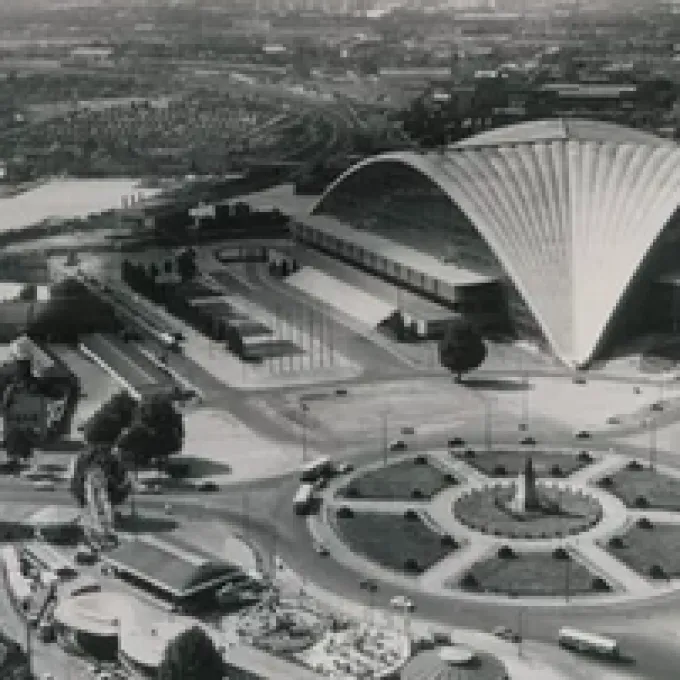
In the 1950s, the Grand Palais no longer offered enough space to host several major exhibitions. The decision was made: bigger was better. And it was for its strategic position on the historic axis of Paris that the La Défense traffic circle was chosen as the site. At the time, the district had nothing in common with what we know today. Dilapidated pavilions, car factories, shantytowns... No one could have imagined such a transformation.
In September 1958, the French government entrusted EPAD with a scope of intervention and the means to carry out its mission. A few months later, the Centre des Nouvelles Industries et Technologies (CNIT) opened its doors. The most popular trade shows of the day followed one another: Mecanelec, Floralies, Arts Ménagers... Everyone admired its spectacular vaulted ceiling. The CNIT was to have an undeniable knock-on effect.
EPAD set to work acquiring land, expropriating property and relocating people. The main principles of the project were laid out in line with the Athens Charter, with pedestrian and car traffic separated. An initial master plan was adopted for the area: 850,000 m² of office space on either side of an esplanade, buildings inspired by the Palais Royal, shops, leisure activities... La Défense became the architects' new playground.
In 1964, the first employees arrived at La Défense. The beginning of a wonderful story.
1965 - 1969
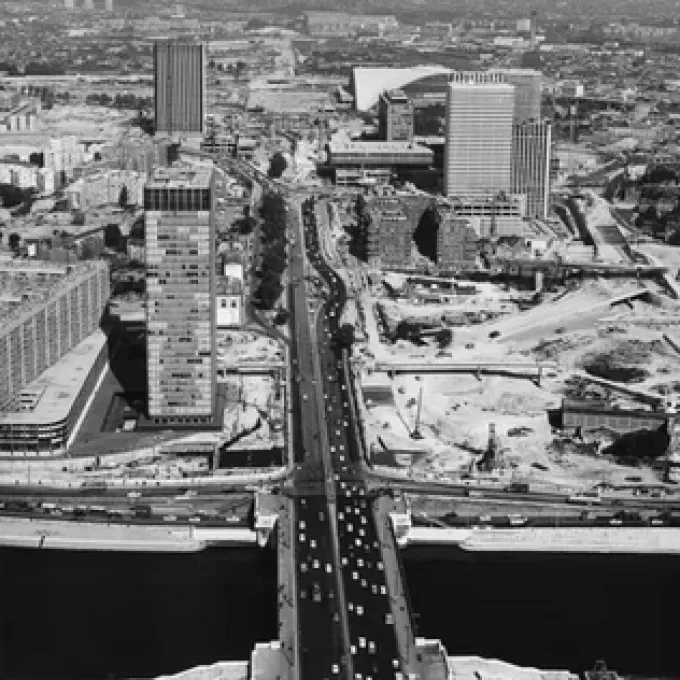
-
As the months go by, construction begins. As decided by the EPAD master plan, the first towers of La Défense are all identical, with a base of 42 by 24 meters, rising to a height of 100 meters.
In 1966, the business district's first tower rose from the ground. Designed by Mailly, one of the architects of the CNIT, La Tour Nobel made history. A year later, the Tour Aquitaine welcomed its occupants.
More towers, more employees, but a poorly served area. The French government came up with a revolutionary solution for the time: the first RER line. The possibility of connecting the Etoile and La Défense traffic circles in less than 5 minutes further encouraged the commercialization of the area.
1970 - 1973
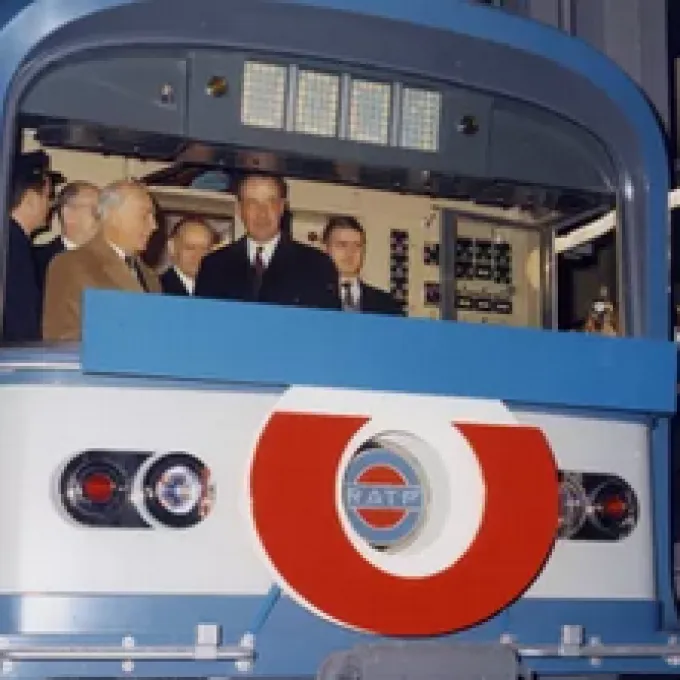
-
In February 1970, the RER went into service. The lives of the site's 12,000 employees had just been turned upside down. Public transport, which had been lacking at La Défense, became a major asset.
France was in the midst of a period of profound economic change and accelerated growth. The tertiarization of the economy accelerated. The needs of certain business sectors were growing, particularly insurance companies. More office space was needed.
But violent protests erupted against these tall towers, which distressed the eyes of Parisians. After studying the possibility of topping a few towers, EPAD reversed course and adopted a new master plan in 1972: to achieve 1.5 million m² of office space throughout the area, which would not only meet demand but also improve the financial equilibrium of the operation.
New work began. Zone B, from Le Parc to Nanterre, was tackled. 6,000 housing units were built to accommodate employees, along with 130,000 m² of additional office space.
The second-generation towers went up: FRANKLIN: 65,000 m², ASSUR: 68,000 m², GAN: 85,000 m², FIAT: 90,000 m².
But everything slowed down with the arrival of the economic crisis in 1973, followed by the oil crisis of 1974. La Défense encountered new difficulties in marketing building rights.
1974 - 1977
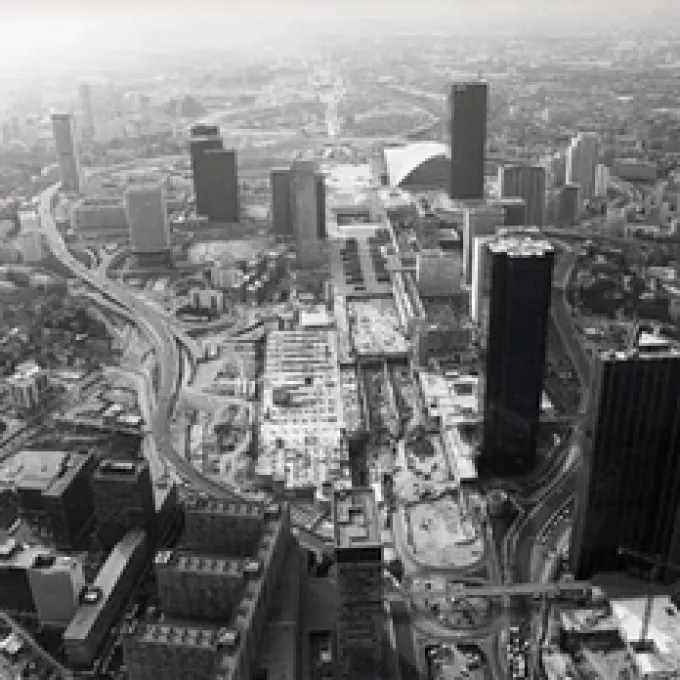
-
600,000 m² empty in 1973 at La Défense. 2 million m² throughout the Ile-de-France region. The region was in dire straits.
From 1975 to 1977, no land was sold. But La Défense was not completely abandoned. A few months after the end of the crisis, business picked up again. New developers (Interconstruction on Ile-de-France, SEERI on Les Miroirs), new users (Citibank on Elysée La Défense), new promises of sale.
1978 - 1982
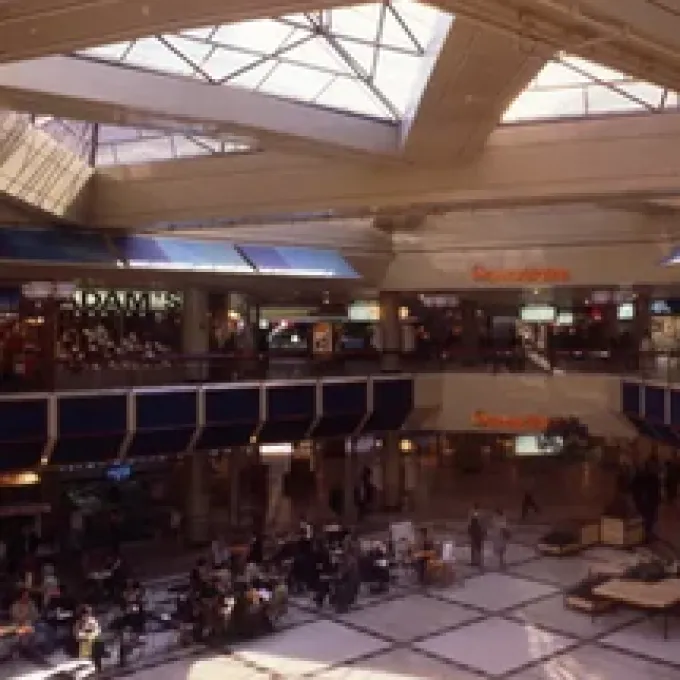
-
On October 16, 1978, Prime Minister Raymond Barre convened an interministerial committee to boost the region's attractiveness: an additional 350,000 m² of office space was authorized, construction of the A14 freeway resumed, and funds were released to improve the environment...
A third generation of offices appeared. Their original design seeks to save energy and operating costs. It also made it easier to adapt to the new technologies of the office revolution.
To support this revival, in 1981 the French Ministry of Public Works moved to La Défense. But the year also saw the opening of Europe's largest shopping mall! Les 4 Temps made its appearance on the La Défense landscape. Over 100,000 m² of stores, department stores, a hypermarket and a pharmacy.... La Défense's retail space is doubled.
1983 - 1992
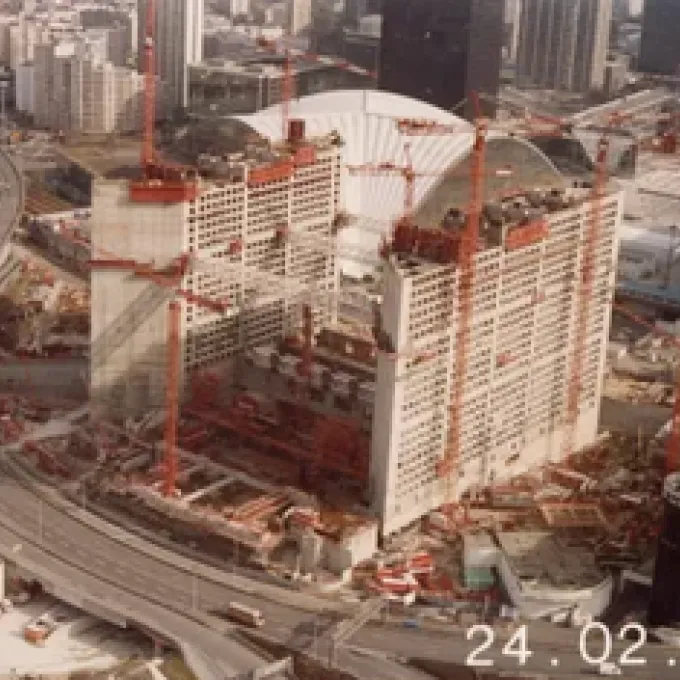
-
A call for projects on the Axis. That's what changed Johan Otto Van Spreckelsen's life forever. He is an architect of Danish origin. Like 424 of his colleagues, he took part in the international competition for the Tête-Défense launched by EPAD in 1982. On May 25, 1983, Johan Otto Van Spreckelsen was quietly fishing on a Scandinavian island, unaware that his obviously simple “Cube” had just been chosen by President Mitterrand, and that the Grande Arche would symbolize the La Défense business district worldwide. The inauguration of the Grande Arche in conjunction with the G7 summit of heads of state on July 14, 1989 brought the image of La Défense to the headlines and international television screens.
This period, seen by some as a golden age for commercial real estate, saw the emergence of a number of major projects at La Défense. One innovation followed another: Hotels such as Sofitel, Novotel and Ibis were built, the CNIT underwent a facelift, the Dôme Imax was created and now offers new exhibition and trade show formats...
The diversity of architectures, real estate products and new configurations goes hand in hand with a much richer spectrum of activities. In all, employment almost doubled over this period, rising from 51,700 in 1982 to over 104,000 in 1990! It was in terms of image that the district underwent its most spectacular evolution. Cultural activities on the site, which had always been a priority for the developer, became increasingly important. Exhibitions by Calder and César, a music festival, a wind festival... Jean-Michel Jarre even staged La Défense in a grandiose spectacle admired by two million spectators spread between the Arc de Triomphe and the Grande Arche. All these events help to attract a public that doesn't already work on site.
And to get all these people to and from the show, the transport system is also being improved! On April 1, 1992, the metro line 1 arrived at La Défense, providing access to the business district for the price of a single metro ticket.
1993 - 1997
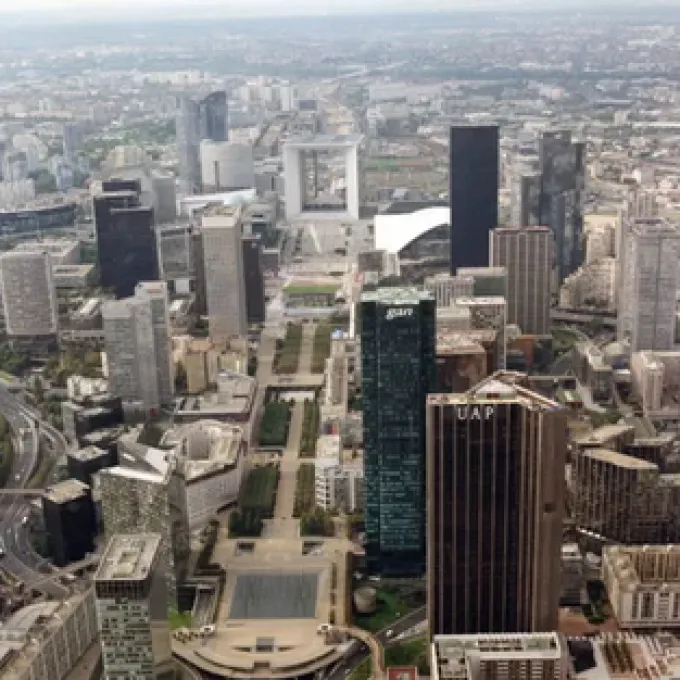
-
Since 1992, Epad has not sold any land charges. Like any other site, La Défense has suffered the effects of the real estate crisis. However, the cessation of sales was not synonymous with the absence of new construction.
It was during this period, for example, that Société Générale moved its head office and all its departments, which had previously been scattered across Paris, to La Défense. The buildings occupied by KPMG and Kvaerner were also completed.
This second crisis is not accompanied by any questioning of the merits of the operation. On the contrary, the image of the business district will continue to improve, particularly in the eyes of its users.
Epad is multiplying its initiatives to develop services. The cabling of the site and all its buildings provides secure high-speed connections. Companies are now connected to the world's first information superhighways, but the quality of these facilities is also attracting new activities and operators, contributing to the emergence of new professions and services with high technological content.
In terms of services and transport, the opening of a special sorting center at La Défense, the introduction of a new simplified signage system, the opening of the Issy-La Défense tramway line and the launch of Cœur Transport, the renovation of the public transport interchange complex, are all high points.
In 1997, the La Défense market began to pick up again, a trend that would increase dramatically in the following years.
1998 - 2004
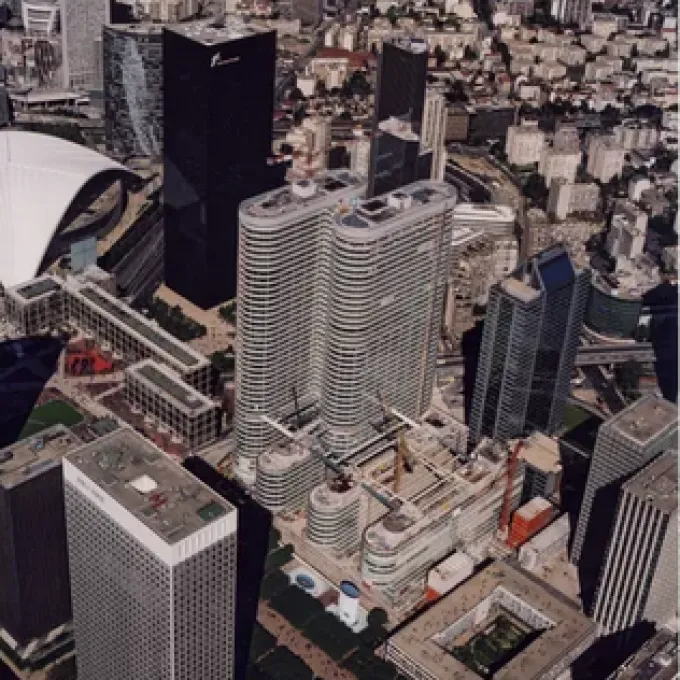
-
At the dawn of the third millennium, La Défense is coming of age and entering an era of essential change. Renovations of the oldest buildings continued apace, including Europlaza and the historic Nobel Tower.
In 1998, Epad signed its first sale in six years with the elegant PB6/EDF tower. New buildings appeared: Guynemer, Triangle de l'Arche, Palatin...
Cœur Défense makes its mark with 190,000 m² of office space. EPAD was not afraid to make a revolutionary change to one of its core areas: work began on transforming the ring road into an urban boulevard. This will allow the construction of two new buildings with innovative architecture: CBX and Exaltis.
Renovation of the large hall at La Défense's Grande Arche station is completed.
Unibail buys the CNIT to give it a new lease of life. Les Quatre Temps embarks on an era of major renovations to revitalize and expand.
La Défense gets a Maison d'église in 2002.
With the support of the Conseil Général des Hauts-de-Seine, activities in the district continue to develop: sports with Tony Parker, parties and shows multiply.
The arrival of Bernard Bled as General Manager of Epad at the end of 2004 paves the way for renewal...
2005 - 2009
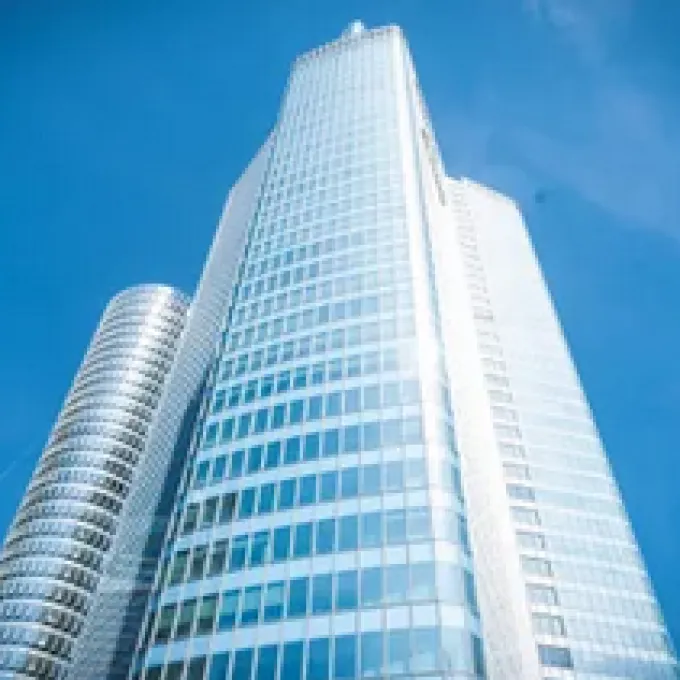
-
La Défense renewal: a shared ambition
Never before has an urban renewal project on such a scale been implemented in such a short space of time: less than two years. In spring 2005, at the request of the French government, Epad began to consider the future of La Défense, which was threatened with obsolescence. An ambitious plan was proposed at the end of 2005. On July 25, 2006, Nicolas Sarkozy, Minister of State, Minister of the Interior and Town and Country Planning, adopted the broad outlines of the renewal plan.
1 - Renovation of obsolete buildings The restructuring of Opus 12 and Initiale (formerly Nobel), in particular, got the ball rolling; the metamorphosis of the Axa tower is set to continue the process: some fifteen of La Défense's oldest towers will be involved in this wave of demolition-reconstruction operations, creating 150,000 m² of new floor space.
2 - Construction of 300,000 m² of new office space La Défense has not completed its development. Rights-of-way gained through the redevelopment of the Boulevard Circulaire will enable the 300,000 m² new office program to be carried out without cutting into public spaces, while respecting the historic axis. These towers will give the district a new architectural ambition.
3 - Construction of 100,000 m² of housing La Défense was built on the premise of urban diversity, which has underpinned its uniqueness and quality of life for the past fifty years. As a result, the increase in the number of service-sector units will lead to an increase in the number of residential units within Epad's perimeter, to the tune of 100,000 square meters of new housing.
4 - Completion of the transformation of the boulevard Circulaire into a peaceful, human boulevard The redesign of the northern section of the boulevard Circulaire in Courbevoie is nearing completion. The impassable artery that separated the slab from the rest of the world has been replaced by a thoroughfare with a human face, providing an urban link between the business district and its immediate surroundings. The southern part of Puteaux is about to undergo the same transformation.
5 - Improving public transport links to the business district A major factor in La Défense's success, its exceptional public transport links will soon reach saturation point. The new development phase initiated by La Défense therefore requires an improvement in the transport network serving the business district. The extension of RER line E (Eole) from Saint-Lazare station to the Mantes-la-Jolie area will be the major project of the coming years. In the long term, it will relieve congestion on line A, which is currently often saturated, while improving links with the West. At the same time, the connection between La Défense and the future Gare de l'Est - Roissy Charles-de-Gaulle airport link is under study.
6 - Modernized governance The creation of the EPGD (Établissement Public de Gestion de La Défense) brings together the local authorities of La Défense (Puteaux, Courbevoie and the Conseil Général des Hauts-de-Seine) to manage and operate the site.
7 - Deploying a policy of commercial and cultural entertainment Despite its proven appeal to tourists, businesses and the general public, the business district still lacks the facilities, events and entertainment that will make it a lively city on a permanent basis, well beyond office hours. New living spaces, new events and a developed cultural life - a source of enthusiasm and an instrument of cohesion - will help transform the image of La Défense.
8 - Priority to sustainable development
With this new phase in its history, La Défense is openly committed to sustainable development. Naturally, this will apply to new buildings and to the management of construction sites, with innovative waste disposal solutions. Epad also intends to apply the same care to the living environment of its employees, residents and visitors, demonstrating that economic development and sustainable development are not mutually exclusive.
9 - Contribute to the balanced development of the Île-de-France region A major economic asset for the Île-de-France region, La Défense must contribute to the balanced development of the entire region, particularly for new projects of national interest.
2009 - 2018
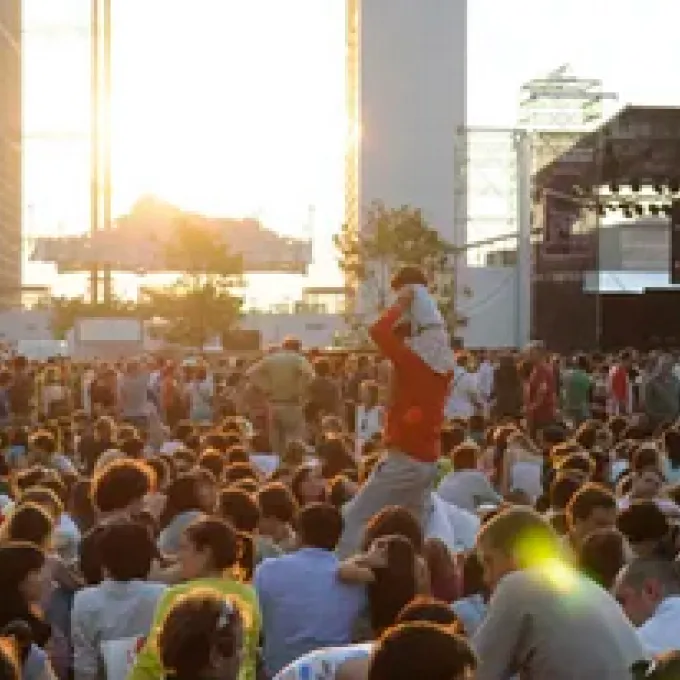
-
As part of the La Défense renewal plan, Nicolas Sarkozy called for new governance of the business district. For the past 50 years, EPAD has been responsible for running the business district, and consequently for its financial management.
The creation of a new structure separates the site's management and development activities. Created by the law of February 27, 2007, the EPGD is responsible for managing, promoting and animating the business district.
Half of its funding is provided by the Conseil Général des Hauts-de-Seine, and the other half by the municipalities of Puteaux and Courbevoie. As of January 1, 2009, the EPGD has assumed the missions entrusted to it by law: management of the business district, upkeep, maintenance, operation, animation and promotion of the public domain are under its responsibility.
EPGD's ambition is to enhance the quality of life on the site in terms of safety, cleanliness and amenity, by multiplying services. The EPGD pursues a proactive animation policy aimed at making the site ever more lively and animated. Cultural events, popular shows and commercial activities will be developed as part of its activities.
In January 2010, EPGD became Defacto, while in July 2010, Epad, still in charge of developing the business district, merged with EPASA, developer of the Seine-Arche ZAC in Nanterre, to become EPADESA.
2018 - à nos jours
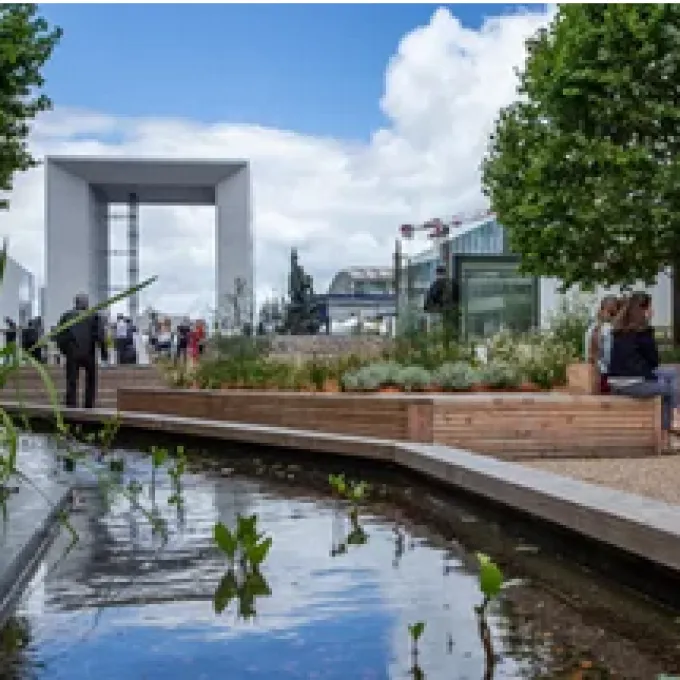
-
At the Comité Interministériel de la Métropole du Grand Paris on October 15, 2015, Prime Minister Manuel Valls announced the need to reconstitute unified management of the La Défense business district in order to strengthen its international appeal and guarantee its balanced development. On this basis, the Prime Minister decided to create a single local public establishment, resulting from the merger of EPADESA and Defacto.
On January 1, 2018, Paris La Défense was born, bringing together development and management skills, enabling the district to pursue its development and compete with its international rivals. The establishment, whose priority is to transform the business district into a living district, continues to ensure day-to-day management, while developing the animation of public spaces and the development of urban projects.
In 2021, Paris La Défense will open a new chapter in its history by giving itself a “raison d'être”. Society's transition to a post-oil world is one of the major challenges of the next decade, and this issue impacts public spaces in the same way as all sectors of the economy. With this new strategic direction, the public institution aims to embody the vision of a low-carbon future for Paris La Défense, by committing to halve the area's greenhouse gas (GHG) emissions by 2030, anticipating the national target of a 40% reduction by the year 2010.
Key figures
-
 1st business district in Europe / 2,800 businesses
1st business district in Europe / 2,800 businesses -
 Over 50 schools and university
Over 50 schools and university
-
 200,000 employees
200,000 employees -
 50,000 residents
50,000 residents -
 70,000 studiants
70,000 studiants
-
 566 ha, including 31 ha of pedestrian areas
566 ha, including 31 ha of pedestrian areas -
 37,35 ha of green spaces
37,35 ha of green spaces
-
 1 hub, with 6 public transport lines
1 hub, with 6 public transport lines -
 + 2 new RER E stations
+ 2 new RER E stations -
 + 2 future Grand Paris Express stations
+ 2 future Grand Paris Express stations
-
 61 skycrapers (tallest buildings), the only high-rise district in France
61 skycrapers (tallest buildings), the only high-rise district in France -
 Top 5 of tallest buildings: The Link / First / Hekla / Majunga / T1
Top 5 of tallest buildings: The Link / First / Hekla / Majunga / T1 -
 Over 60 works of art
Over 60 works of art
-
 45,000 seats at Paris La Défense Arena, Europe's largest indoor concert hall
45,000 seats at Paris La Défense Arena, Europe's largest indoor concert hall -
 Westfield Les 4 Temps-CNIT, 1 of the largest shopping destinations in Europe
Westfield Les 4 Temps-CNIT, 1 of the largest shopping destinations in Europe -
 More than 200 restaurants, and 20 Food Trucks / 3,000 hotel rooms
More than 200 restaurants, and 20 Food Trucks / 3,000 hotel rooms